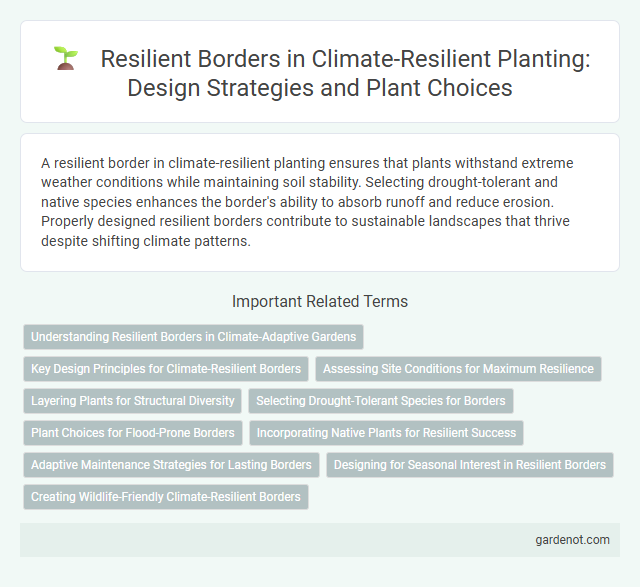A resilient border in climate-resilient planting ensures that plants withstand extreme weather conditions while maintaining soil stability. Selecting drought-tolerant and native species enhances the border's ability to absorb runoff and reduce erosion. Properly designed resilient borders contribute to sustainable landscapes that thrive despite shifting climate patterns.
Understanding Resilient Borders in Climate-Adaptive Gardens
Resilient borders in climate-adaptive gardens utilize drought-tolerant and native plant species to withstand extreme weather conditions while enhancing biodiversity. These borders improve soil health through deep-rooted plants that prevent erosion and retain moisture, supporting long-term garden stability. Incorporating diverse plant textures and heights creates microclimates that mitigate temperature fluctuations and promote ecosystem resilience against climate change.
Key Design Principles for Climate-Resilient Borders
Resilient borders in climate-resilient planting emphasize the use of native, drought-tolerant species that enhance soil stability and support biodiversity while minimizing water use. Key design principles include incorporating layered vegetation to create windbreaks, using permeable materials to reduce runoff, and planning for adaptive management to respond to shifting climate conditions. Effective border design also integrates habitat corridors that facilitate species migration and maintain ecosystem connectivity under climate stress.
Assessing Site Conditions for Maximum Resilience
Evaluating soil composition, drainage patterns, and microclimate variations is essential for establishing a resilient border that withstands climate extremes. Accurate assessment of sunlight exposure and wind direction helps select plant species with optimal tolerance to temperature fluctuations and drought. Integrating native vegetation adapted to local conditions enhances the border's long-term sustainability and reduces irrigation needs.
Layering Plants for Structural Diversity
Layering plants in climate-resilient borders enhances structural diversity by combining ground covers, shrubs, and trees to create multiple protective layers. This approach increases ecosystem stability, improves microclimates, and fosters habitats for beneficial insects and wildlife. Diverse plant layers reduce soil erosion, conserve moisture, and buffer against extreme weather, promoting long-term garden resilience.
Selecting Drought-Tolerant Species for Borders
Selecting drought-tolerant species for resilient borders enhances landscape sustainability by reducing water dependency and improving plant survival under arid conditions. Plants such as lavender, Russian sage, and agave exhibit high drought resistance and maintain aesthetic appeal, making them ideal for border planting in climate-resilient designs. Incorporating native drought-adapted species further supports local biodiversity while minimizing irrigation needs and soil erosion.
Plant Choices for Flood-Prone Borders
Choosing flood-tolerant plant species such as willows, bald cypress, and switchgrass strengthens border resilience by stabilizing soil and improving water absorption. These plants possess deep root systems that reduce erosion and withstand prolonged water saturation, enhancing the durability of flood-prone areas. Incorporating native wetland vegetation further supports ecosystem balance while providing natural flood mitigation along vulnerable borders.
Incorporating Native Plants for Resilient Success
Incorporating native plants into resilient border designs enhances climate resilience by supporting local ecosystems and improving soil stability. Native species are adapted to withstand regional climatic fluctuations, reducing maintenance and water usage. Using a diverse mix of native plants creates a robust barrier that mitigates erosion, promotes biodiversity, and provides essential habitats for pollinators and wildlife.
Adaptive Maintenance Strategies for Lasting Borders
Resilient borders in climate-resilient planting rely on adaptive maintenance strategies that adjust to changing environmental conditions, such as fluctuating rainfall and temperature extremes. Utilizing drought-resistant species and regular soil health assessments ensures the longevity and effectiveness of these borders against climate stressors. Implementing smart irrigation techniques and timely pruning further enhances border resilience, reducing vulnerability to erosion and pest outbreaks.
Designing for Seasonal Interest in Resilient Borders
Designing resilient borders for seasonal interest involves selecting plant species that thrive across varying climate conditions and exhibit staggered blooming periods. Incorporating native perennials, drought-tolerant shrubs, and evergreens enhances visual appeal while ensuring adaptability to temperature fluctuations and precipitation changes. Strategic layering of plants with diverse textures and colors supports ecological stability and sustained biodiversity throughout the year.
Creating Wildlife-Friendly Climate-Resilient Borders
Creating wildlife-friendly, climate-resilient borders involves selecting native plant species that provide habitat connectivity and support biodiversity under changing climate conditions. These plantings enhance ecosystem services such as pollination, temperature regulation, and soil stabilization while acting as buffers against extreme weather events. Integrating diverse, drought-tolerant, and pest-resistant vegetation ensures long-term resilience and promotes sustainable wildlife corridors.
Resilient border Infographic

 gardenot.com
gardenot.com